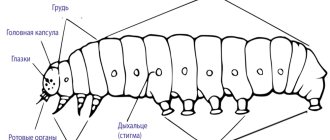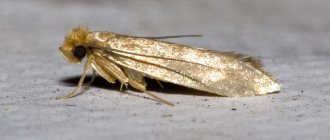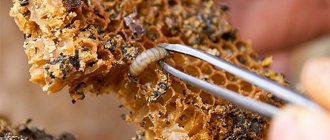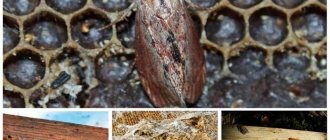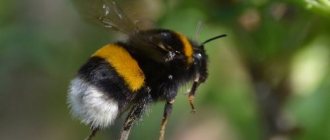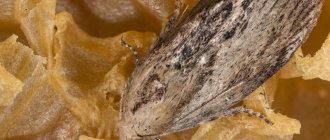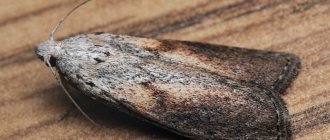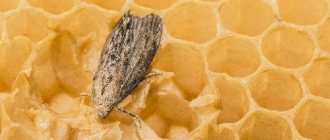Wax moth
Wax moth - bee moth Photo: wax moth - Galleria Mellonella
The large wax moth (Galleria Mellonella), a moth of the moth family (Pyralidae), is evolutionarily adapted to living in a beehive and is known to all beekeepers as a pest. Often the large wax moth is simply called a moth or a bee moth, which is not entirely true, since there are more than 6,000 species in the family of moths (Pyralidae), and in the family of bee moths (Galleriidae), in addition to the large one, there is also a small wax moth, the larvae of which have no medicinal properties . The bee moth is found wherever beekeeping is developed, mainly in the southern regions. Wax moths attack weak bee colonies or waxy raw materials, where they lay eggs, from which caterpillars emerge after 5-10 days. The caterpillars (larvae) of the large wax moth initially feed on beebread, pollen and honey. Then they eat the wax and remnants of the cocoons, and make passages entwined with cobwebs in the honeycombs, thereby damaging the honeycombs and dry land. Large wax moth larvae are the only living creatures that have the unique ability to digest and assimilate beeswax. Wax moth causes great harm to beekeeping.
Reasons for appearance
Many people wonder where food moths come from in a house where regular cleaning is carried out. He cannot accidentally get into the apartment from the street, since he cannot fly that well. The butterflies that flutter around the house are males. Female butterflies move much more slowly, mostly jumping from place to place. Therefore, even if a male has flown into a dwelling, without a female he will not be able to reproduce.
Food moths appear in the house along with contaminated grains, sugar or dried fruits brought from the store.
Inside the bags there are already eggs or moth caterpillars, which are then spread throughout the apartment. They get to us through cuts, tears, punctures in the packaging or when packaging the goods at the factory. Comfortable conditions for the reproduction of food moths are temperature + 22 ... 25 ° and air humidity above 60%.
Large and small wax moth
The large wax moth (Galleria Mellonella) and the small wax moth (Achroia Grisella) belong to the family of moths (Pyralidae), currently separated by entomologists into a separate family - wax moths (Galleriidae). Like most moths, large and small wax moths are small moths that are nocturnal and parasitic in bee hives and warehouses of wax raw materials.
Great wax moth (Galleria mellonella)
Females of the great wax moth butterfly have a length of 13-35 mm and a wingspan of 18-32 mm, males are smaller; their length is 9-13 mm, and their wingspan is 17-23 mm. The wings and body of butterflies are covered with scales; when at rest, the wings are folded into a “boat”. The forewings are violet-gray with brown spots in females and yellowish with red-brown spots in males. The hind wings are light gray (with an ash tint) and have dark strokes along the edges. The body of the butterfly (under the wings) is cream-colored. The head is elongated, gray or brown with large faceted eyes and a short proboscis. On the head of females there are long, straight and densely scaly labial palps. The number of males and females has a ratio of 1:1.14, characteristic of solitary insects. The oral and digestive organs of adult wax moths are not developed; they do not feed and live off the nutrients accumulated in the larval stage. The lifespan of females is 5-12 days, males up to 27 days. To lay eggs, females often choose hives with weak bee colonies, which they enter at night and leave before dawn. Females lay eggs in separate batches on the walls of cells with fresh pollen or honey, in the cracks of frames, on the walls or at the bottom of the hive. The eggs are oval in shape, white or light cream in color, smooth, 0.35 -0.5 mm in size. Over the course of her life, a female large wax moth can lay up to 3,000 eggs.
What plants are threatened by insects?
To begin the fight against a harmful parasite, you need to find out the type of attacking moth.
| Variety | What crops does it affect? | Signs of defeat |
| Potato. | Potatoes, peppers, tomato, eggplant, tobacco. | Plants take on an anemic appearance, the foliage becomes covered with a thin cobweb. |
| Onion. | Onion garlic. | The leaves of the crop turn yellow and dry out, and the plant quickly dies. |
| Cabbage. | Cabbage, rutabaga, rapeseed, radish, mustard, radish, turnip. | The affected vegetable shrivels, the fruits begin to rot, the buds are eaten away, and holes appear on the leaves. |
| Tomato (mining). | All types of tomatoes. | Withering of plants, death and rotting of fruits. |
| Apple (ermine). | Fruit trees. | They eat the leaf mass, the leaves turn yellow, dry out, and can destroy up to 80% of the fruit harvest. |
| Grape (circle). | Vine plantings. | Oily patches appear on the foliage, and the vine gradually dries out and dies. |
| Wax (fire). | Bee hives. | Cobwebs appear on the bodies of bees, and their flight slows down. |
| Poplar. | Almost all green spaces and fruit trees. | The appearance of eaten away cavities on the foliage, the leaves acquire a mosaic color. |
| Rowan (variegated). | Rowan, apple trees. | Dark spots on the fruits, perforated leaves. |
| Bud (currant). | Raspberries, currants, blackberries. | The bushes become as if burned or frostbitten, the leaves wither and curl. |
There are species of moths that suck the tears of sleeping animals. The large Madagascar moth is famous for this.
Great wax moth
Male and female Great Wax Moth Picture: Male and female Great Wax Moth (Galleria Mellonella)
Large wax moth larvae.
Lesser wax moth (Achroia grisella)
It is as common as the large wax moth. Females have a length of 7-12 mm and a wingspan of 15-23 mm, the length of males is 4.5-9 mm, their wingspan is 12-17 mm. The forewings of an adult butterfly are narrow, the hind wings are shorter and wider than the forewings. In a calm state, the wings are folded like a roof and slightly overlap each other at the ends. The color varies from ash-gray to dark yellow. On the forehead there is a patch of short yellow hairs. The butterfly's body is flat, its head is lowered. The mouthparts are undeveloped - butterflies do not feed. The number of males and females is approximately the same. The female small wax moth lays eggs in the cracks of the hive, less often in the cells of the honeycomb. The eggs are round or oval in shape, yellow-white in color, 0.2-0.35 mm in size. A female small moth can lay up to 400 eggs. Unlike the larvae of the large wax moth, the larvae of the small wax moth do not have medicinal properties.
Sense organs
Only mosquitoes and honey bees can boast of this type of receptor, developed to a unique state with a huge number of possibilities. But nature has not endowed moths with such a wide range of advantages.
The “fluff” on the body of the caterpillars provides the larva with a sense of touch. Insects sense touch very well using long tactile hairs that grow over almost the entire surface of their exoskeleton and are connected to nerve cells that transmit contact information to the insects' brain.
Sensory hairs on the body of adult individuals are located throughout the body, especially on the antennae. In addition to tactile and “culinary” sensitivity, they provide information about the speed and direction of the wind while the insect is in flight.
Lesser wax moth
Lesser wax moth male and female Picture: male and female Lesser wax moth (Achroia grisella)
Small wax moth larvae.
Beekeepers often confuse large and small wax moths, since the size and color of the moths are variable and depend on the qualitative composition of the honeycombs on which the insects feed in the larval stage and the temperature at which they develop.
Prevention
It is always easier to prevent moths from appearing than to fight them, so you must adhere to the following rules:
- Before bringing food, items or old furniture into your home, carefully check them for the presence of larvae and adult moths.
- If you find contaminated food, throw it away.
- Wash items from second-hand stores at 60°C;
- Ventilate your kitchen cabinets periodically. If you have an ultraviolet lamp, it can be used instead of sunlight.
- Place a clove of garlic in the container with cereal.
- Have geraniums in your house.
- Place anti-moth tablets in the cabinets.
Use aromatic oils in cabinets and cabinets with food, which not only repel moths , but also smell pleasant. Compliance with the described rules and recommendations will help protect the house from the appearance of moths, and if this dangerous pest penetrates it, then effectively fight it.
Medicinal properties of wax moth larvae
Recently, articles have appeared on the Internet claiming that wax moth products are a placebo, since there is no scientific justification or evidence of their effectiveness. Articles with such statements were written by incompetent people or out of ignorance (for example, on Wikipedia), or for the purpose of promotion in search engine results (for example, on a group of affiliated satellite sites about the control of domestic insects) and have nothing to do with real information about scientific research on medicinal products made from wax moth larvae do not have the properties and effectiveness of use.
The healing properties of wax moth larvae were known in ancient Asian countries and Egypt. In Russian folk medicine, from ancient times they were used to prepare remedies for the treatment of age-related changes and tuberculosis.
The first scientific studies of wax moth larvae date back to the end of the 19th century. The Russian scientist Nobel Prize winner I. I. Mechnikov drew attention to the ability of a folk remedy to cure tuberculosis. It was Mechnikov who first suggested that the larvae of bee moths (Galleria mellonella) may contain substances capable of lysing (destroying) the waxy membranes of tuberculosis bacteria.
Preventive measures
The best way to prevent food moths from recurring in your home is to be careful when shopping. It is best to buy cereals in transparent packages so that you can visually assess their quality. Foreign spots, small lumps, thin cobwebs are signs of food moth infestation.
You should not buy food on sale - this is often how the seller gets rid of goods affected by bugs.
It is better to heat flour or cereal purchased at a big discount in the oven at a temperature of + 80 ... 120 ° for 30 minutes or put it in the freezer overnight. It is recommended to pack all bulk products in hermetically sealed containers so that food moths cannot reach them. Cabinets need to be cleaned regularly to ensure that stitched or insect-infested grains are removed promptly. Kitchen countertops should be cleaned from time to time with a strong vinegar solution, which repels food moths.
Mechnikov I. I.
Mechnikov Ilya Ilyich (1845-1916) Photo: Mechnikov I. I. - the first researcher of the medicinal properties of wax moth
Mechnikov Ilya Ilyich (1845-1916) - Russian scientist Nobel laureate in physiology and medicine in 1908 “For his work on immunity.” Among I. I. Mechnikov’s numerous awards is the Copley Medal of the Royal Society of London, an honorary doctorate from the University of Cambridge, and he is also a member of the French Academy of Medicine, an honorary member of the St. Petersburg Academy of Sciences and Moscow University, and a member of the Swedish Medical Society. Mechnikov is one of the founders of evolutionary embryology, the discoverer of phagocytosis and intracellular digestion, the creator of the phagocytic theory of immunity, and the founder of scientific gerontology. Since 1887, head of the laboratory at the Pasteur Institute in Paris.
Mechnikov’s idea about the ability of wax moth larvae to destroy the membranes of tuberculosis bacteria formed the basis for a large series of studies by the Russian immunologist Professor S.I. Metalnikov. Metalnikov experimentally proved and substantiated that the high immunity of wax moth larvae to a number of microorganisms pathogenic for humans (causative agents of tuberculosis, diphtheria, tetanus, plague, etc.) is due to a specific enzyme - cerase, which breaks down wax.
Folk methods of struggle
The use of ancient methods of pest control is based on the fact that moths are repelled by pungent odors. Therefore, to protect food supplies they often use:
- garlic;
- laurel leaf;
- tobacco;
- citrus peels;
- aromatic herbs and spices.
Fragrant leaves of rosemary, mint, lavender, as well as cloves, allspice, and bay leaves are placed in cabinets and containers with bulk products.
Periodically, it is recommended to wash grocery storage areas with diluted vinegar.
Metalnikov S. I.
Metalnikov Sergey Ivanovich (1870-1946) Photo: Metalnikov S.I. - author of the name of the digestive enzyme of wax moth larvae: cerase
Metalnikov Sergei Ivanovich (1870-1946) - Russian scientist: biologist, zoologist, immunologist. Published more than 250 scientific papers in the field of comparative physiology of invertebrates, applied microbiology and immunology in Russian and Western European languages. Some of Metalnikov's works opened up new areas of research. In 1907–1908 worked in the laboratory of I. I. Mechnikov at the Pasteur Institute in Paris. Since 1919, he has been a permanent employee of the Pasteur Institute, where he studied the immunity of invertebrates (primarily insects) and the connection between immunity and the activity of the nervous system. The founder of psychoneuroimmunology, a new field of medicine. Author of the famous book “The Problem of Immortality and Rejuvenation in Modern Biology” (1924), dedicated to the phenomenon of aging of the body.
You can find many publications on the Internet, including on Wikipedia, in which the existence of the cerase enzyme is questioned and all authors of scientific papers on the medicinal properties of wax (bee) moth larvae are called “persons not known in either medical or biological circles.” " If the authors of such publications do not know the names of Mechnikov, Metalnikov and other scientists, as well as numerous publications (list of published scientific articles) in authoritative scientific publications, then a logical question arises - what relation do such authors have to medical and biological circles?
In addition to Metalnikov (the author of a large series of publications on the immunity of wax moth larvae: Metalnikov, 1906, 1907, 1908, 1915, 1921; Metalnikov, 1907, 1908, 1920, 1921, 1935) an enzyme preparation that has a destructive effect on tuberculosis bacteria and has high lipolytic activity in relation to the lipids of Mycobacterium tuberculosis (Koch's bacillus), Mankiewicz E. was isolated from the larvae of the great wax moth (Mankiewicz, 1949; 1952). The antimicrobial effect of wax moth larvae extract against Mycobacterium tuberculosis was also confirmed in the works of other authors (Olivier, 1947; Kuzniecow and Wojciechowski, 1950; Paszewski, 1959).
A large series of studies of the cerase enzyme was carried out by the Bosnian biochemist MK Muftic (Mahmud Kamal Muftic) at the Tuberculosis Research Institute (Borstel Center) in Schleswig-Holstein (Germany) and the Biochemical Laboratory at the University of Lausanne (Switzerland). Scientific work of MK Muftic on the study of the enzyme cerase and its activity against Mycobacterium tuberculosis in the period 1955-1970. published in authoritative scientific journals around the world (British Journal of Tuberculosis, Enzymologia, Tubercle, Indian Journal of Medical Sciences, Pathologia and Microbiologia, The Japanese journal of tuberculosis, etc.).
MK Muftic
Mahmud Kamal Muftic (1925-1975) Photo: MK Muftic – author of scientific works on the digestive enzyme of wax moth larvae
Mahmud Kamal Muftic (MK Muftic 1925-1975) - Bosnian biochemist, published about 40 articles on bacteriology (including tuberculosis) in medical journals around the world. He is a co-author of several patents owned by the German pharmaceutical company Schering AG (now Bayer AG). From the end of 1940 to the beginning of 1960, MK Muftic worked as a doctor and researcher in several countries of the Middle East (Egypt, Iran, Saudi Arabia). Since 1962 worked at the Tuberculosis Research Institute in Schleswig-Holstein, West Germany. Since the late 1960s, he has been employed in the biochemistry laboratory at the University of Lausanne in Switzerland and collaborated with the biochemistry department at Trinity College Dublin.
Modern studies of wax moth larvae extract, conducted at the Institute of Cell Biophysics of the Russian Academy of Sciences, confirm the existence in the high-molecular fraction of acidic serine protease (cerase enzyme), capable of dissolving cell membranes. According to researchers from the Institute of Cell Biophysics of the Russian Academy of Sciences, it is the proteolytic enzyme, serine protease, that plays a leading role in the resorption of blood clots and plaques in blood vessels and lung tissue, as well as in the regeneration of scar tissue after a heart attack.
A major contribution to the study of the medicinal properties of wax moth belongs to the Moscow cardiologist and homeopath S. A. Mukhin. Even in his youth, a folk remedy made from wax moth larvae helped him cope with his own illness - tuberculosis. In his works devoted to the treatment of cardiovascular diseases, S. A. Mukhin was able to scientifically substantiate and prove the prospects of using wax moth larvae extract in the treatment of atherosclerosis, cardiosclerosis, angina pectoris and myocardial infarction, as well as tuberculosis and senile diseases.
Mukhin S. A.
Mukhin Sergey Alekseevich (1905-1981) Photo: Mukhin S.A. - scientifically proved the effectiveness of wax moth extract in the treatment of cardiovascular diseases
Mukhin Sergey Alekseevich (1905-1981) – Russian scientist: homeopath, cardiologist. One of the founders of the Moscow homeopathic school. Since 1934, he worked at the Institute of Cardiology on his dissertation and was the best student of Professor D. D. Pletnev. Co-author of uniquely important works on atherosclerosis. Throughout his life, Mukhin studied ancient manuscripts of traditional medicine, which formed the basis of later pharmacology. Being a famous homeopath, Mukhin fought against the unfair persecution of homeopathy by official Soviet medicine. It is precisely because of the non-acceptance of homeopathic methods of treatment by official Soviet science that very little is known about the multifaceted research and achievements of S. A. Mukhin.
The amazing ability of wax moth larvae extract to restore tissue after deep morphological damage (to resolve fresh scars after a myocardial infarction, as well as to heal tuberculous cavities in the lungs and replace them with healthy tissue) was proven in the 1980s by Professor M. N. Kondrashova at the Institute of Biological Physics AH CCCP.
General composition of wax moth extract/tincture
Thanks to the unique diet of large wax moth larvae, which includes substrates rich in biologically active substances (breadbread, honey and beeswax containing propolis, as well as bee waste products: royal jelly, bee and drone brood), LVM extract has a complex and balanced chemical compound.
| Chemical compound | Content of wax moth larvae in the extract (% dry matter) |
| High molecular weight substances | 2 |
| Nucleotides and nucleosides | 1,5 |
| Free amino acids | 50-60 |
| Monosaccharides and disaccharides | 2-4,7 |
| Fatty acid | 0,1 |
| Minerals | 7,1-9,1 |
Full chemical composition of wax moth larvae extract.
Wax moth larvae extract contains a large amount of free amino acids, monosaccharides and disaccharides, nucleotide bases and their derivatives, fatty acids, biologically important elements and trace elements (potassium K, phosphorus P, copper Cu, manganese Mn, selenium Se, chromium Cr, molybdenum Mo, magnesium Mg, cobalt Co, calcium Ca, zinc Zn, iron Fe, etc.). The high molecular weight fraction of the extract contains acidic serine protease (cerase enzyme) and aromatic compounds associated with sugars and amino acids. The extract of wax moth larvae contains biologically active substances that stimulate the contractile activity of smooth muscles and accelerate the growth of cells and tissues.
Usually, when describing the valuable components of propolis, royal jelly or drone jelly, decenoic acids are especially emphasized. But few people know that the extract of wax moth larvae also contains decenoic acids , namely: oleic (cis-9-octadecenoic acid) and palmitoleic (cis-9-hexadecenoic acid) acids.
Decenoic acids are unsaturated fatty acids, found only in the body of bees and humans, secreted by the glands of bees and have no analogues in nature. Decenoic acids have high biological activity, an antiviral effect at the cellular level and a powerful anti-inflammatory effect. Decenoic acids are effective against the toxoplasma virus in the cells of the nervous system and liver, thereby helping to stabilize and regulate the nervous system and restore liver function.
Everything described above refers to a real extract (tincture) made from freshly collected wax moth larvae grown on natural food - dark waxy sushi with the remains of bees.
In the last few years, products have appeared on sale that are allegedly made from wax moth larvae, but in reality are not such. Some of these products are just pacifiers - placebos, and some are really dangerous to health. You can learn about how not to buy a fake or dummy instead of a real product made from wax moth larvae, why wax moth extract cannot be bought in a pharmacy, how the extract differs from a tincture, as well as about us and our experience, from the article “Wax moth - where to buy ?.
The initial stage of pest destruction
When you discover the first signs of kitchen moths in your apartment, you need to take certain actions to get rid of the pest.
- To do this, first of all, you will need to sort through all the bags, pouches and other containers with food products in order to identify the pest larvae.
- If you find pasta, flour, cereals and other products affected by worms, you should get rid of them.
- You will have to spend time examining all stocks of nuts, dried fruits, dry food, seeds, cereals and other bulk products for contamination. All spoiled stocks must be destroyed as they are unsuitable for further use. Their further storage will lead to active reproduction of the pest in the apartment.
- Food reserves that seem untouched at first glance should be calcined in a frying pan or frozen for a couple of days.
- The next step is to treat the kitchen cabinets and shelves. They must be washed with soapy water or a solution of vinegar and water. In this case, special attention must be paid to seams and door hinges. It is convenient to treat narrow cracks and hinges with a brush dipped in a vinegar solution.
After careful treatment, the cabinets are left with the doors open for ventilation and drying.
Application of extract and tincture of wax moth larvae
The list of diseases for which the extract/tincture of wax moth larvae is effective is constantly growing, as research into the medicinal properties of the larvae is being conducted by scientists from different countries. To date, the effectiveness of using LVM extract for the following diseases has been scientifically substantiated and clinically proven:
- tuberculosis of the lungs and other organs (tuberculosis of the lymphatic and digestive system, tuberculosis of bones and joints, tuberculosis of the genitourinary organs, skin, eyes, tuberculosis of the central nervous system, tuberculosis of the meninges, etc.);
- diseases of the cardiovascular system (atherosclerosis, myocardial infarction, coronary heart disease, angina pectoris, cardiosclerosis, cardiac arrhythmias, hypertension, myocarditis of various etiologies, vegetative-vascular dystonia, varicose veins and other diseases of the cardiovascular system);
- bronchopulmonary diseases (bronchitis, pneumonia, pleurisy, bronchial asthma, fungal diseases of the lungs, etc.);
- gynecological diseases (infertility, toxicosis of the first half of pregnancy, disorders of the structure of endometrial cells, anemia, menopausal disorders, placental insufficiency, etc.);
- andrological diseases (prostate adenoma, low sperm motility, male infertility, impotence, decreased libido, low testosterone levels, etc.);
- during the recovery period after operations and injuries (after extensive inflammatory processes, suppuration and surgical interventions);
- as a general strengthening agent that enhances immunity (extract/tincture of wax moth larvae is a powerful natural immunostimulant).
Read more about treatment with wax moth larvae extract in the section “Wax moth - treatment”.
It is worth especially noting that, despite its high efficiency, the extract/tincture of wax moth larvae has no side effects or contraindications, with the exception of individual intolerance. Also, taking the extract is compatible with most pharmacological drugs, including anti-tuberculosis antibiotics.
Take LVM extract/tincture drops (the number of drops depends on the disease, weight and age) dissolved in water (50-100 ml) 30-40 minutes before meals 2-3 times a day. The minimum course of admission is 3 months. For children 5-14 years old, courses last 21 days, then a break of 21 days. For adults 3 months daily.
You can learn more about the methods of using extract/tincture of wax moth larvae for various diseases, as well as calculate an individual dosage regimen online (depending on your disease, weight and age) using an interactive calculator in the “Wax moth - application” section.
Cleaning the premises
Experts recommend not limiting yourself to washing kitchen cabinets and shelves, but carrying out a general cleaning of the entire room after a complete audit of food supplies.
All furniture, floors and walls should be thoroughly washed with a solution of laundry soap, and then wiped with vinegar diluted with water. The gaps between kitchen furniture and walls need to be vacuumed, as well as the spaces between cabinets and cabinets.
Adults can hide under the windowsill, on the ceiling or on the wallpaper. Therefore, it makes sense to use chemical pest control agents after eliminating spoiled products and general cleaning of the premises.
Answers to questions about wax moths and LVM products
Will wax moth tincture/extract help me recover from a severe traumatic brain injury? I'm feeling down...
“During the recovery period after injuries, wax moth larvae extract (preferably 25%) helps well.
The extract increases endurance and speed of muscle recovery, increases the body's energy supply, enhances hemoglobin synthesis and promotes calcium absorption. The essential amino acid valine contained in the extract is a natural anabolic, increases muscle coordination and...” Read more…
My son and I, as contacts of patients with bacillary tuberculosis, were prescribed preventive treatment with isoniazid. Of course not...
“Yes, such cases do happen; it was enough for everyone to take LVM extract without isoniazid (even with changes in the tuberculin test).”
Read more…
I recommended wax moth tincture to a friend for the treatment of tuberculosis. She was treated for three weeks and now she says...
“LVM tincture has a mucolytic and bronchodilator effect, improves the drainage function of the bronchi.
If there was stagnation of sputum, then it will separate (and should!), which will temporarily cause a cough - this is not a side effect, but a normal effect.” Read more…
Is it possible to take wax moth larvae extract or tincture during pregnancy? Which product to choose (tincture,…
“The most suitable product for use during pregnancy is a 25% extract of wax moth larvae (since when taken, the alcohol component is 2.5 times less).
It is better not to take wax moth tincture, since it is not filtered and contains plant pollen, which in some cases can cause allergic reactions (especially if you have an individual intolerance to the products..." Read more...
How is delivery carried out in winter? Do weather conditions have any effect? We have -30.
“For 8 years we have been sending to all regions (including the northern ones) and in any weather.
The extract contains 40% ethanol - it will not freeze.” Read more…
Is it possible to give 10% wax moth extract in alcohol to a 4-year-old child with a tuberculin test, what is the dosage regimen and...
“For a child of this age, it is difficult to calculate the effective dosage of wax moth larvae extract.
In general, for children under 14 years of age, the dose is 1 drop for 1 year, in your case it is 4 drops diluted in 50-70 ml of any healthy liquid (juice, water, etc.), take 2 times a day for 30-40 minutes before eating. Although the proportion of alcohol in this case is negligible, it should be borne in mind that simultaneous use..." Read more...
Can wax moth tincture be used in the treatment of stroke and from what day?
“LVM extract is used to treat the consequences of strokes; use can be started from 14-21 days.”
Read more…
The child is 2 years old, often suffers from bronchitis and acute respiratory infections, the doctor advised him to take 2 drops a day of wax moth tincture 10%,…
“It is advisable to give children not the tincture, but a 10% extract of wax moth larvae (the tincture can cause allergic reactions).
For a 2-year-old child - dosage and regimen: course 21 days, 2 drops 1 time per day, while monitoring the reaction - for skin rashes or other manifestations of individual intolerance; then a break of 21 days; if tolerated normally, repeat the course (break..." More details...
Why is LVM extract still not used in the treatment of tuberculosis in official medicine, because so many patients...
“The extract of wax moth larvae is not included in the register of medicines, because it is a very complex and expensive procedure.
For your information, only 10-20 new drugs (not generics, but fundamentally new ones) are registered all over the world per year, and the cost of development, clinical trials and other procedures reaches a billion dollars. Only large pharmaceutical companies can do this…” Read more…
